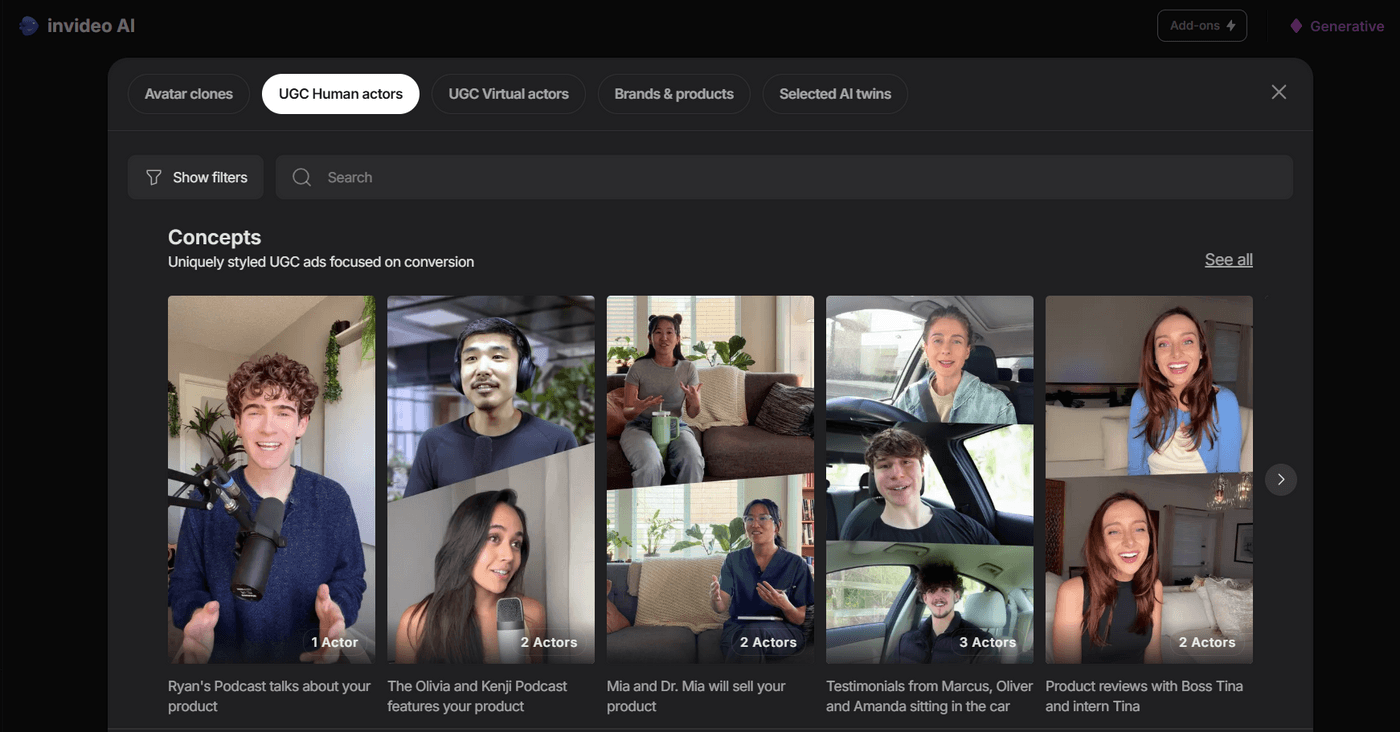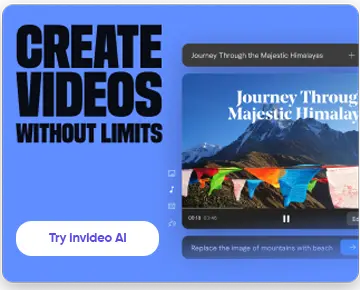If no one remembers your product after watching your ad, it missed the mark. That might not have been a big deal a decade ago. But now, every second of user attention counts. And that’s a real problem today because people scroll, swipe, and move on in seconds.
This is exactly why product advertising matters more than ever, ensuring your offering gets the spotlight it deserves by highlighting its unique value and why it's the smartest choice for your customers.
If that’s what you’re currently struggling with, you’ve found the best guide that discusses the all things product advertising, including:
- What Is Product Advertising
- The Goals of Product Advertising
- What Are the Types of Product Advertising
- Channels Used in Product Advertising Today
- Why Product Advertising Matters More Than Ever
- Successful Examples of Effective Product Advertising
So, without any further delay, let’s dive in!
Create UGC Product Ads
Use AI avatars in invideo AI to generate high-quality UGC-style product videos for any platform.
 Create now
Create now
What is Product Advertising?
Product advertising is one of the best marketing strategies to promote a product (or service) that specifically highlights its features and benefits. The ad might explain how the product works, what's unique about it, or even just show it in action. The idea is to help the customers visualise the experience of using it, so they feel naturally more confident about buying it.
A big part of this process is educating people because potential customers often don't realise they need something until it's shown to them clearly. These ads just break down the product in simple terms to make the message easy to understand, while being persuasive enough.
Over time, this format builds trust and loyalty as people get consistent reminders about the quality or any other aspect of a product. This way, product advertising connects it to a customer's needs in a clear, direct, and convincing way.
The Goals of Product Advertising
As beneficial as it is for your marketing strategy, product advertising helps in achieving multiple goals at the same time. Some of the most significant ones are:
Highlight Key Features and Benefits
One of the main goals of product advertising is to clearly communicate what the product does and why it's worth a try. When people are presented with multiple options, it's natural that they would look for features that match their needs. For example, saying that a washing machine uses “inverter technology” is just technical jargon unless the ad actually explains the “how.”
As Tim Cook rightly puts it, “A great product isn't just a collection of features. It's how it all works together.”
When a value proposition is communicated with such clarity, customers don't just understand the product but can also visualise how it would fit into their daily life. It gets easy for them to understand how the product can solve their problem. That's exactly what product advertising aims to do.
Build Trust in Product Quality
Once the benefits are made clear, it's also important to build trust in its quality. This is because no matter how great a product sounds, people won't buy it unless they actually believe it works. This is one gap that product advertising perfectly fills as it takes the customer through real reviews, demonstrations, or just a consistently clear messaging that builds trust.
If customers themselves see the products solving real problems, showing up reliably, and getting positive feedback, it's natural that they would start to associate it with quality. Once this happens, it becomes a lot easier for them to choose it over others, even if they are not ready to buy it right away.
Generate Immediate Sales or Conversions
This goal comes into play when there is a clear opportunity to capture ready-to-buy customers. This can be during effective sales, a product launch, or even just a slow week that just needs a boost. In these situations, ads are designed to get straight to the point by highlighting one strong benefit, creating urgency, and making it easy for people to take some action.
This way, product advertising removes every small barrier that could stop someone from buying a product or trying a service. However, the offer needs to be easy-to-understand, the buying process should be quick, and the messaging should speak directly to a real need.
Dealing with Declining Product Sales
When a product's sales start declining, there can be multiple reasons behind it. Maybe the messaging went wrong, the audience's taste has changed, or new competitors have entered the market. Whatever the reason is, product advertising can help you reset the narrative by figuring out why the interest dropped and using your strategy accordingly to fix exactly that.
For example, if one of your products was popular during lockdown but has now started fading, you might run a campaign showing how it fits into the post-lockdown lifestyle. Or, if your competitor is focusing on price, your ads can double down on the quality or long-term value. Either way, product advertising can help you re-position and experiment with new angles to tackle declining sales.
⚡ Bonus tip: In case your product hasn’t changed but people often forget about it, you can run ads that would reintroduce it with a twist. For example, you can use the nostalgia factor and put it across like, “Still works like magic. Just like you remember!”
Promote Cross-Sell or Upsell Opportunities
When a customer buys from you, it's not the end but a starting point where product advertising can help in increasing the customer's lifetime value. This can happen by offering complementary products or better versions of products they are already using.
For example, if a customer is already using a basic software plan, showing them how the premium plan solves more problems can be helpful. Similarly, if you are going for cross-sell suggestions, it is likely to work best when shown during the checkout process in follow-up emails or simply through remarketing ads.
What are the Types of Product Advertising
Product advertising takes different shapes and forms depending on the goal, timing, and other factors that influence the required approach. However, the 3 main classifications of product advertising include:
Comparative Advertising
Comparative advertising is when one brand openly compares its product with another brand’s product to show customers that its product is better in some way. This type of product advertising is typically used when brands want to grab attention quickly and create a strong impact by showing a clear and direct difference between them and a competitor.
An interesting example of comparative advertising is Wendy’s 2022 campaign that showed a bent fry shaped like McDonald’s famous golden arches and added the line, “Hot & Crispy Fries Don’t Arch. Just Sayin’.” They didn’t mention McDonald’s directly, but the curved fries and the arches made it obvious who they were talking about.

Source: Food NDTV
Comparative advertising became more structured when the Federal Trade Commission released a statement of policy in 1979, encouraging a more decent and transparent approach. It stated that even advertisements that pinpoint competitors are legal as long as the comparison is not false or deceiving. The focus here was to promote fair competition among companies.
Competitive Advertising
Competitive advertising is another form of product advertising that's quite different from comparative advertising in the way it is approached. This format simply focuses on promoting the product's own strength and what makes it special to build demand for the brand without dragging a competitor into the conversation.
The main difference here is that comparative ads directly mention the competitor, while competitive ads just focus on standing out either through features or benefits of one’s product. This approach is usually safer as it avoids any possible legal trouble or negative publicity. However, both strategies help in driving attention and improving sales – just in different ways!
Innovative Advertising
As the name implies, innovative advertising is done when there is a need to create demand for a new product, which is usually needed in the initial stages of a product's life cycle. Since the product is new in the market, there is a greater need to explain the product's benefits and features in detail to make as many people aware of it.
Make Videos with AI Influencers
Invideo AI lets you create product videos featuring AI influencers without any filming.
 Try it now
Try it now
Channels Used in Product Advertising Today
Today, product advertising takes place through multiple channels and models. However, if we look at the broader classification, there are two main categories. The first one includes traditional platforms, and the other one consists of digital platforms. Let's understand these in a bit more detail, one by one.
Traditional Platforms
Before we had digital platforms, traditional media was the main way for brands to promote their products. These include channels like television, radio, and print, which are still very relevant in many industries like entertainment and retail.
Television
Television uses visual storytelling to give you a broad reach, as it works well for launching new products and running campaigns that need a strong emotional appeal. It may be expensive, but the brand recall it creates is really powerful, especially during prime time slots or big events. That's why it is relevant when the goal is to reach a mass audience.
Radio
Radio helps in reaching regional audiences, especially for local businesses and brands that want to stay at the top of minds through regular mentions. Although it's just the audio, smart scripting and catchy voices often make the advertisement attractive. Hence, it works out well to promote a particular product or service.
Print media includes newspapers and magazines, and are often targeted for specific interest groups that still prefer reading over watching. The products often have a more long-lasting presence due to the physical nature of print. Naturally, there is a good chance to ensure repeated visibility for the product or service being advertised.
Digital Platforms
According to a 2025 research by GWI, a social media user spends 2 hours 23 minutes per day (on average) on social platforms. Clearly, people are spending a significant part of their time on digital platforms every single day, which makes it easy for brands to directly access highly targeted audiences. However, each platform has a different purpose:
Social Media
Platforms like Instagram, Facebook, LinkedIn, and TikTok have their specific set of audiences. Brands focus on their particular target audiences by narrowing down their search to pre-defined parameters like age, gender, interests, location, and even behaviour. This becomes a powerful medium as ads can easily blend into the user’s feed, which makes it feel less like a promotion.
Video Advertising
A 2023 report by Insivia found that more than 92% of all internet users globally watch videos online every week. With such a massive audience preferring video format, video advertising has seen major success in recent times and continues to be a favourite. However, UGC – especially with AI-driven capabilities has come up as an interesting new trend.
AI UGC Ads
UGC (User-generated content) ads have always been a more natural way to spread the word to your audience that feels more genuine than any other paid media. But ever since AI has been integrated in almost every other area, brands are increasingly using it to create better and more cost-effective AI UGC content.
Tools like invideo AI have made it even easier to create UGC video ads within minutes with specific hooks, styles, and other customisations. These include functionalities like:
- Diverse actor library
- More than 50 languages to connect with the global audience
- Studio quality product b-roll, scripts with CTAs, SFX background music, etc.

All you need to do is select an AI actor, add product details, customize the script language, subtitles, and other elements, and your UGC video is ready to download. This way, you can use avatars of real influencers to create authentic and relatable content without having to depend on real influencers.
Generate Ads with AI Avatars
Create product ads in selfie-style, walk-and-talk, or demo formats using AI avatars and your product images.
 Generate now
Generate now
Why Product Advertising Matters More Than Ever?
In 2025, brands don't face the same challenges that they used to 5 years ago. As a brand, you have new trends to keep up with, customers with an evolved mindset, newer technologies entering the market, and so on. Keeping all these factors in mind, no wonder that product advertising matters more than ever. Here are other key reasons to note:
Targeting Specific Customers
With more and more products in the market and even shorter attention spans, generic messaging just doesn't work anymore. Product advertising (when done right) allows you to directly speak to the people who are likely to care about your product.
To target a specific category, platforms like Instagram, Google, or YouTube let brands run focused campaigns based on their interests, past purchases, and behaviour. This level of precision targeting was not possible a couple of decades ago, and that's exactly why product advertising has become such a powerful tool.
This matters more than ever because customers are now flooded with options. So, if your ad doesn't speak to their exact need or pain, they would rather scroll past it. That's why it's important to stay relevant to your target customers so that you reach the right person at the right time – with the right messaging!
Reinforcing Brand Image
Often, when a customer buys a product, they are not really buying it but the brand behind it. Product advertising gives you an opportunity to consistently shape how your brand is perceived, whether you want to be seen as affordable, premium, or environmentally conscious. It helps you build that brand image to reinforce the specific identity you want to establish.
This consistency is important because buyers are often skeptical. If what they see in your ad doesn't match what they hear from others or experience after purchase, all the trust comes breaking down. Effective product advertising ensures that the product's benefits, values, and purpose are communicated in a way that aligns with your brand’s promise.
Establishing a Better Connection With Customers
Consumers today expect brands to understand their needs, which is a big reason why it’s more important than ever to build and maintain a good relationship with customers. Plus, people now engage with brands across multiple platforms, including social media, email, video, and even chat. So if your advertising feels one-sided or robotic, chances are that it might get ignored.
However, if your product ad can start a conversation or make someone feel seen, it creates an emotional layer that's hard to replicate. This relationship-building role leverages product advertising to earn that attention and maintain a strong connection with the customers.
Distinguishing from Competitors
Almost every product category is crowded today, which is why you aren’t likely to be the only option. So, how do you really stand out? Product advertising can help here by giving you the stage to show exactly how you are different and convince your potential customers to believe in that differentiation.
This is even more relevant and equally critical today because buyers are more informed than ever and do their own research before buying anything. If you don't make your value clear upfront, they will move on to a competitor who does. It's as simple as that. Hence, good product advertising lets you control the narrative by telling them why they should choose you.
3 Successful Examples of Effective Product Advertising
Several well-known as well as lesser-known brands have demonstrated effective product advertising through their marketing campaigns. Let's look at 3 such successful examples.
1. Pringles - “Sad Device” 2019 Super Bowl Ad
In its 2019 campaign, Pringles came up with an interesting ad, showing two people stacking different Pringles flavours to try out new combinations while a smart speaker beside them interrupts and complains about how it can't enjoy the same as if it is “stuck in a digital prison.” It ends on a humorous note, showing how machines can't enjoy simple pleasures like we can.

Source: YouTube
It was an interesting way to promote a product feature without any generic claims like “ it tastes better” or “more crunch.” The ad captures a specific idea that made the product memorable for people while contrasting human experience with emotionless devices. That's exactly the kind of product-centric yet emotionally driven messaging that cuts through the noise today.
2. Tetley’s “Now We're Talking” Campaign
This 2019 campaign by Tetley introduced animated characters like Dave the dog and Ella the cat, who are shown chatting over tea. The concept here is that a cup of tea can spark honest and everyday conversations, using light humor to encourage debates like “milk first or tea first?” It focused on building genuine connections with people, especially with a massive audience.

Source: YouTube
Tetley used its product to stand for human connection, and this kind of product advertising focuses not just on what the product is but actually what it represents. Instead of pushing the usual “better taste” or “premium leaf,” the brand focuses on showing the role their product plays in people's lives.
3. Unigloves x Superside - AI-generated Ad for Derma Shield
Unigloves, a brand that makes protective gloves and skin care products, collaborated with Superside to promote their Derma Shield product. This involved creating more than 250 product images that had real-world elements like fire stations, tattoo studios, and labs. With this, the brand effectively showcased its products in dozens of use cases.

Source: Superside
This approach is highly relevant in B2B and niche industries where budget and time constraints often limit creative output. Therefore, this campaign helped the brand reduce overall production cost, enter the market faster, and still show high-quality visuals catering to different customer segments.
FAQs
1. How is product advertising different from brand advertising?
Product advertising focuses on promoting a particular product or service, whereas brand advertising goes beyond that. It aims at building the overall image of a company rather than a specific product.
2. What really makes a product ad effective?
An effective product has a clear message, attractive visuals, and a strong call to action that connects with the target audience and shows exactly how it solves the problem.
3. Can small businesses benefit from product advertising?
Yes, definitely. It can help a small business reach new customers and improve its sales.
Make Ads Without Filming
Create authentic creator-style product videos with invideo AI with no camera or real actors needed.
 Create now
Create now
Final Thoughts
Your product is the core part of your business, and if people don't understand what makes it valuable, everything else can fall flat. Product advertising shows your product in the best light possible, which makes its strengths clear and relevant to the right audience.
Many businesses put time and money into marketing, but forget that it all depends on how well the product itself is communicated. Strong product advertising fills this gap by clarifying, connecting, and convincing your customers in the best way possible!
If you want to learn more about marketing your brand, you should definitely check out our YouTube channel.
Here are some other helpful resources to learn how you can do a lot more with AI to make money online:
- How to Monetize Instagram Reels in 2025
- How to Make YouTube Shorts: Create YT Shorts Using AI
- How to Use ChatGPT to Make Money: 7 Passive Income Ideas


